Bleekeri Cichlid is another name for the Starry Night Cichlid. They are huge and beautiful creatures that originate from Madagascar Island. In the African-themed freshwater tropical aquariums, this species is used as centerpieces. As the name suggests, these are dark Cichlids with light spots all over their bodies. They are known for their beautiful patterns. This Cichlid represents the beautiful night sky with its color. This Cichlid is known to beautify an aquarium space with its vibrant colors.
You will find these beautiful Cichlids in the Betsiboka river drainage in the northwest portion of the Madagascar island. However, the Betsiboka river has turned into a victim of deforestation and industry pollution in recent times. As a result, the once clean waters are now heavily polluted, and soil erosion has ruined the beauty of this river. This pollution has endangered the lives of the Starry Night Cichlid that live in this river. Because of their endangered nature, they are sold in pet shops and are bred commercially. The Starry Night Cichlid has been listed on the endangered list. Hence, there are restrictions on where this fish can be shipped. If you plan to bring home this fish, it is better to check with the local per shops to know if these Cichlids are shipped to your location.
You might be wondering if these species are easy to care for. Well, if you know how to deal with them in the right way and if you are confident enough, you will not have an issue with taking care of them. If you plan to buy a Starry Night Cichlid or already have one. If you are confused about taking care of them, you are in the right place! This guide will help you understand ways to take care of your Cichlid. In this guide, you will know more about their suitable tank mates, their size, diet, etc. This guide will help you learn more about Starry Night Cichlid. So, buckle up and read on!
Also Read: 7 Aquascaping Styles for Aquariums
Table of Contents
Starry Night Cichlid : A Quick Overview
The starry night cichlid is a brightly colored fish native to Africa. It is favored in aquariums for its vibrant colors and peaceful nature. It is a medium-sized fish, easy to care for, and known for its blue and orange markings.
About Starry Night Cichlid
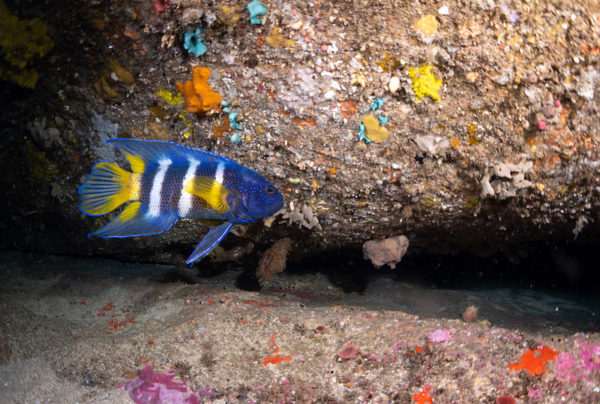
| Common Name | Starry Night Cichlid |
| Scientific Name | Paratilapia Polleni |
| Origin | Madagascar Island |
| Suitable temperature | 76-82°F |
| Average Size | 10-12 inches |
| Tank Size | 120 gallons per pair |
| Diet | Carnivorous |
| Lifespan | 13 years |
| pH level | 8.0-8.5 |
| Water Hardness | Soft to medium |
Behavior
The Starry Night Cichlid’s are known to be aggressive. Hence, it is not advisable to keep them with other fish. This is because their presence and aggressive behavior can endanger the lives of the other fish. This fish is known to be a territorial fish and hence can be aggressive. They are known to be aggressive during the spawning season.
However, do not be scared. The Starry Night Cichlid is known to be less aggressive around those species that would not get into their territory. We would also advise you not to keep them with smaller fish because they could get eaten by your Starry Night Cichlid. Always look for other Cichlids of the roughly same size to house with your Starry Night Cichlid. This will lead to lower chances of aggression. We will cover more about Starry Night Cichlid and their suitable tankmates below.
Size and Lifespan
The size of a Starry Night Cichlid can range from 10 to 12 inches. The male Starry Night Cichlid is known to be larger than the female one. Adult males will have a hump or a small bump on their foreheads.
The lifespan of a Starry Night Cichlid is 13 years. If your Cichlid is healthy and kept in a comfortable environment, it can live a long life.
Starry Night Tank Mates
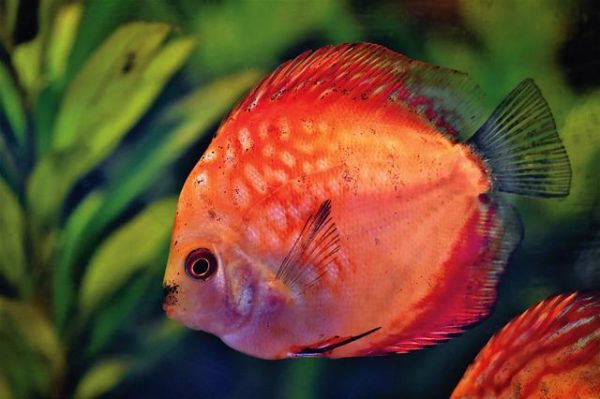
As mentioned above, the Starry Night Cichlid can be an aggressive species. Hence, it is not advisable to keep them with other smaller species. Their territorial behavior makes them aggressive and makes them defend their territory. Therefore, managing their aggressive behavior can get complicated. Always keep them with other Cichlids that are of a similar size. Keep them with species that would not get into their territory. It is always better to house them with a schooling species. This is because a schooling species will be harder to bully. When choosing other Cichlids, it is better to choose other Madagascar Cichlids as their tank mates. This is because Cichlids tend to be less aggressive towards their own kind.
The Starry Night Cichlid is usually kept in larger aquariums. This is because larger aquariums mean more space and hence lesser chances of them clashing with other species. Therefore, if you plan to keep this species, we suggest that you try looking for an enormous aquarium.
Here’s a final list of other species that you can keep them with:
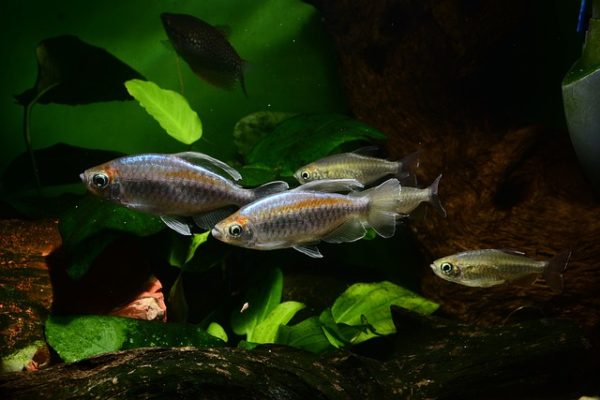
- Congo tetra
- Clown loach
- Red-tail shark
- Scavenger catfish
- Leopard Bushfish
- Synodontis catfish
Starry Night Tank Size
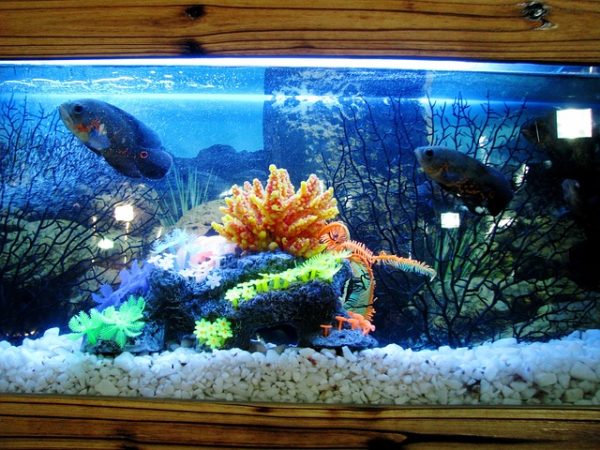
A pair of Starry Night Cichlids need a minimum tank size of 120 gallons. Their large size requires them to live in a larger space. Hence, a larger tank size will serve as a good investment for this fish. It’s possible that putting them in a tinier tank will restrict their progress. If you plan on keeping well over single pair of Starry Night Cichlids, you should be twice the size you’d need for just a single couple. A duo of Starry Night Cichlids may occupy a three-foot-long territory in the tank.
Tank Set-Up
Whenever you are cleaning a large tank, you should utilize automated tasks as much as possible. Pebbles are shifted around by Starry Night Cichlids to create burrows. Thus, the tank filtration must be positioned around the aquarium’s outside if feasible to avoid being revealed and chewed on. Starry Night Cichlids enjoy flowing water, so make sure you have a strong enough filtration to replicate the streams they find in their native habitat. Gravel should be used as a base, with more enormous rocks arranged in vault formations. It will allow them to feel more safe by simulating their native habitat. There must be no way for Starry Night Cichlids to see each other if you have more than two of them. You may even try to set up zones for them within your tank. This will aid in the reduction of hostility. When selecting rocks and aquascaping your aquarium for your Starry Night Cichlids, make sure to use smoother pebbles that will not scratch or harm your Starry Night Cichlids. When it comes to botanical décor, you’ll need it sparingly all around the tank. As they’re reorganizing and constructing their nests, you’ll note that they’ll retrieve vegetation and the substrate. Because Starry Night Cichlids enjoy a sparsely vegetated tank.
Also Read: 20 Best Freshwater Aquarium Plants for Beginners
Starry Night Care Guide
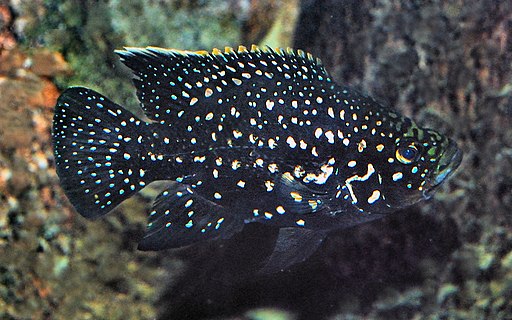
Overall, water conditions are undemanding for starry night cichlids as the temperatures stay within their optimal range of 76 to 82°F. For effective single species or communal tanks, their size and temperament necessitate more significant tank dimensions, suitable décor, and acceptable tank mates for effective single species or communal tanks.
To attain their maximum size, starry night cichlids require plenty of space. With fish reaching 12 inches in length, this necessitates tanks with a baseline capacity of 120 gallons for a pair. Limiting their development by keeping them in smaller tanks is a good idea.
If you want to have anything other than a pair, you’ll need to double the tank size virtually. Remember that this will take care and upkeep much more difficult. Large tank maintenance is best handled by automating as many duties as possible, such as water changes and bottom cleansing.
This cichlid species push gravel and sand by mouth to create nests, exposing and nibbling on subsurface filters. As much of the filtering system as feasible should be kept beyond the tank. It’s crucial to have a decent water return. Starry night cichlids are native to rivers and like swimming in them.
Starry night cichlids, like other cichlids, exhibit a lot of rage. They can be hostile towards their own kind and moderately to openly antagonistic towards other tank mates. Using tank décor to create zones for your Starry Night Cichlid is one method to help minimize aggressiveness.
Because their natural environment is based on rocks. Setting up a decent gravel basis with many larger stones placed in tunnels or brickwork caves will make them feel at ease. This will help if you plan to keep more than a pair of the Starry Night Cichlid. To avoid eye contact and aggressiveness, position the rocks and caves so that the line of vision around them is as short as possible.
Creating shelters to contain entire grown adult species will help maintain your aquarium in the long run without making significant alterations. The use of pebbles with uneven or sharp edges should be avoided since they will scratch fish and expose them to further injury and sickness. Plants and other plants should be utilized carefully since the fish might have the urge to dig them up.
Diet
Cichlids such as The Starry Night Cichlid, are carnivorous fish known as piscivores. Piscivores are animals that eat mostly fish for their diet. Starry Night Cichlids will attack their victims in the natural environment, swallowing them entirely if they get near enough. They also kill for food in the tanks in the same way they would if you fed them live fish. They do not, however, require live fish to thrive. They will accept smaller fish, pellets, shrimps, and worms as their food.
Also Read: What Can You Feed Fish Other Than Fish Food?
How big does a starry night cichlid get?
You will be able to see the Starry Night Cichlid grow significantly at the rate of three to four inches each year. However, this is possible only if it is adequately cared for and kept in the appropriate tank size. At three years old, Starry Night Cichlids attain full development.
Starry Night Disease
1. Swim Bladder Disease
As the name implies, the disease of the float affects the part of the cichlid known as the float. A float is an epithelial-lined abdominal sac that helps fish float. If the cichlid has a floating bag disease, it will be challenging to stay in the water. There are many possible causes of this disease. Trauma from physical injury can affect the float and certain secondary illnesses such as cancer and tuberculosis. Another common cause of this condition is diet. Fish that suffer from malnutrition and constipation are more likely to develop swim bladder disease. To treat this condition, it is essential to address the root cause of the problem. If the fish feed is inadequate, feed a variety of diets and high-fiber diets such as peas and spinach to relieve constipation.
2. Tuberculosis
Tuberculosis is an exceptionally infectious and frequently fatal illness in aquarium fish. It’s one of the few infections that may be transferred to people by coming into touch with open wounds or ulcers. Lack of appetite, ragged fins, white patches on the body, and sinking of the belly are classic symptoms of the condition. Affected fish may also exhibit behavioral abnormalities, such as becoming sluggish or apathetic. If even one of your fish shows these symptoms, make sure that all other fish are relocated to the hospital tank, and the tank is medicated with Melafix. Before the fish are transferred to the original tank, they must be carefully cleaned and disinfected.
3. Cotton Wool Disease
Cotton wool sickness is a very simple disease to recognize because affected cichlids develop fuzzy white developments on their heads, fins, and scales. This illness is caused by a parasite that may be typically found in aquariums. However, it only becomes an issue when the quality of water is inadequate. Fish are more susceptible to fungal illnesses like a cotton wool disease when unconsumed fish food and other organic debris collect in the aquarium, and the quality of water deteriorates. Stress and previous injuries may also make cichlids more susceptible to fungal diseases. An antifungal drug or a saltwater bath are the most popular treatments for this condition.
Also Read: Discus Fish : Complete Guide to Care
Final Thoughts
So, should you keep a Starry Night Cichlid as your pet? This completely depends on your willingness to care for them and their needs. We believe that this fish (which is aggressive) can help make your tank look more attractive. If you give them what they need concerning their tank size and water parameters, you will be able to raise a healthy Starry Night Cichlid in your tank.
No related posts.
